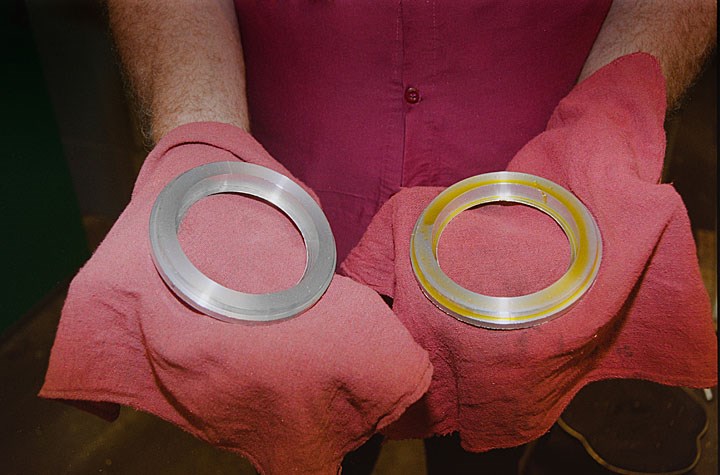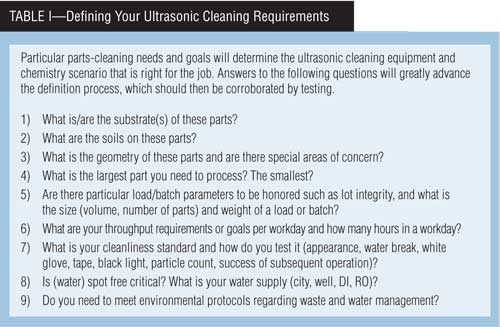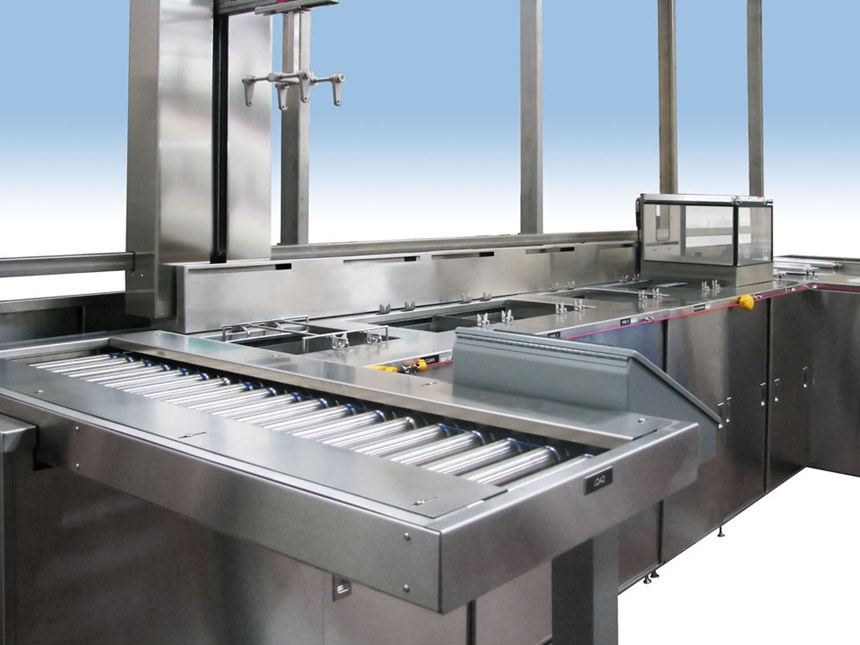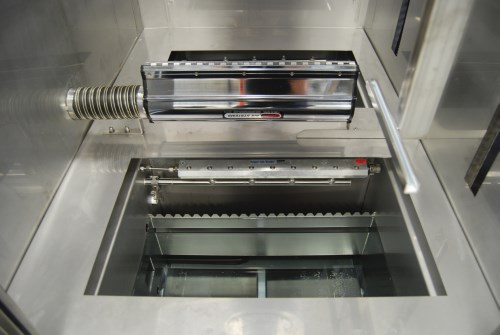Ultrasonic Cleaning Systems Deliver Results and Efficiency
Appears in Print as: 'Adding an Ultrasonic Edge'
Tips to help you choose a system for profit, performance and quality.
#basics
When should you consider adding ultrasonics to a cleaning process? Usually, the answer is whenever parts are not getting clean enough using the current method. Ultrasonics become a viable purchase when cleaning issues are negatively impacting productivity, quality and/or the bottom line. Effective cleaning with ultrasonics has been proven in a wide range of industries ranging from microscopic medical devices to reconditioned locomotive shafts, from aerospace parts to parts prior to coating, and more.
Ultrasonics can be included in a new cleaning process or sometimes can be retrofitted into an existing process. In many cases, rejects due to residue on parts can be virtually eliminated with the addition of ultrasonics into clean and/or rinse stations in a properly-configured parts cleaning line.
Featured Content
Ultrasonic Frequency and Watt Density
Ultrasonic energy occurs when sound waves are introduced into a solution such as water via a package that includes one or more ultrasonic generators and corresponding ultrasonic transducers.
The sound waves create microscopic bubbles of solution during periods of positive pressure, which implode and release a burst of energy during periods of negative pressure. This process is called cavitation. It is cavitation that enhances the separation of soils from substrates, often making ultrasonic cleaning faster, gentler, and more effective than other methods. Imploding bubbles travel wherever the solution goes, allowing cleaning activity even within complex part geometries and micro-parts.
When cleaning with ultrasonics the frequency of the sound waves is matched to the application. Frequencies range from 20 kHz to 170 kHz and above. The most commonly recommended ultrasonic frequency is 40 kHz. It is considered the “universal frequency” because it is generally safe for use in most applications and will produce the most intense cavitation energies to remove the most common types of contaminants (oil, grease, metal chips) from the widest range of substrates.
Lower frequencies such as 20 or 25 kHz produce larger cavitation bubbles which are more aggressive when they implode. These lower frequencies are especially suitable for applications like removing contaminants such as buffing compound from stainless steel medical implants or removing the byproducts of injection molding from steel or stainless steel molds.
Higher frequencies (68-250 kHz) will produce smaller cavitation bubbles with less intense energies, but more of them. These can be beneficial in the removal of smaller particles and where damage is a concern (polished surfaces, delicate parts, soft substrates, micro-parts).
While ultrasonic devices have a natural frequency variation, additional frequency modulation is now available through sweep frequency generators. Frequency-sweep circuitry varies the frequency of the ultrasonic generator to create a more uniform cleaning field by alleviating standing waves and hot spots sometimes characteristic of older equipment.
Power control circuitry tailors the output to varying load conditions, thus improving versatility, which is especially useful when different types of parts are being cleaned in the same line. Multiple frequency generators are also available and may be appropriate when cleaning a variety of part families or complex geometries in the same line.
The other critical variable in specifying ultrasonics is watt density. This is the recommended number of watts of ultrasonics per gallon of solution in a tank. In addition to the volume of the tank, this number varies depending on the substrate of the parts to be cleaned, the contaminant(s), and the weight and mass of the maximum load.
Monitoring ultrasonic performance has become critical as ultrasonics are used more and more in precision cleaning scenarios where repeatability and conformance are mandatory. Monitoring is also useful in tracking the lifespan of an ultrasonic package. Readings can be captured by measuring outgoing generator wattage and correlating it to an analog scale that is readable by PLC’s or stand-alone meters. On an automated, PLC-controlled line these readings can be reported (and if desired alarmed out) in real time on the human/machine interface (HMI) which is typically a color touch screen.
Designing an Ultrasonic Cleaning Process
As with any type of equipment, ultrasonic cleaning systems should be matched as closely as possible to the job requirement. Labs and production areas with lower throughputs may choose a single ultrasonic tank followed by a sink rinse. Single tanks typically start at less than one gallon and up. Higher production areas may consider a manual or automated multiple station line in which one or more ultrasonic cleaning stations are followed by one or more rinses and an optional dryer.
Heavily contaminated parts may benefit from cleaning in more than one cleaning station. The first clean can remove gross contamination and the second completes the job. Ultrasonics may or may not be indicated in both stations depending on the type and level of contamination. For example in a scenario with heavy oil loading, a pre-clean might involve ultrasonic cleaning with surface skim to a coalescer to handle the oil. Once the heavy oil is removed in the first station, the ultrasonics in the second clean will be cavitating more directly with the part substrate to perform finer cleaning.
Tank construction is typically 300 series stainless steel, insulated to minimize heat loss. An ultrasonic tank work area should allow for at least two inches of clearance on all sides of the work load.
Small ultrasonic tanks are typically equipped with electric strip heaters, and the ultrasonic transducers are epoxy-bonded or vacuum brazed to a diaphragm usually located in the bottom of the tank.
Larger ultrasonic tanks usually feature heavier duty wall construction and additional wall support. Heat may be supplied in a variety of ways including electric immersion heaters, steam coils, and/or external heat exchangers. Larger tanks may have either diaphragm-bonded transducers, or immersibles which are transducers bonded into a stainless steel can which is then mounted in the cleaning tank. The advantages of immersibles are that a can may be swapped out if required without the whole tank going down, and immersibles can often be retrofitted into existing process tanks to improve cleaning performance.
Chemistry and Temperature
The kind of chemistry used in an ultrasonic cleaning tank can significantly impact cleaning success. Before the Montreal Protocol in 1988, what we now call “regulated solvents” such as 1.1.1. were often the cleaning solutions of choice in ultrasonic tanks. Today, they and a new generation of solvents remain an important option for certain types of cleaning, as is another class of cleaning solution called “semi-aqueous” which mixes solvents and water. But the biggest change after the Montreal Protocol has been the shift to aqueous cleaners for many types of parts-cleaning applications.
There are three types of aqueous cleaners: acidic, neutral, and alkaline.
Acidic cleaners (pH less than 6) consist of mineral and organic acids with wetting agents. They are generally not used for the removal of oil and grease, but are most widely used for the removal of metal oxides. With the addition of ultrasonics this process can be accelerated and the acid used can therefore be less aggressive.
Neutral cleaners (pH of 6 to 8) consist mostly of surfactants. They also contain mild builders and corrosion inhibitors. They are effectively used to remove oil and light grease.
Alkaline cleaners (pH of 8-14) are a blend of builders such as potassium and sodium hydroxide, silicates, carbonates, bicarbonates, phosphates, borates, and surfactants. They are best suited for the removal of oil, grease, inks, and carbonaceous soils.
The efficiency of all of the water-based cleaners increases in combination with ultrasonics and heat. However, raising the temperature too high (above about 180°F) reduces cavitation pressure and can therefore be counter-productive to ultrasonic cleaning success.
Optimizing Solution Performance
Besides too high temperatures, gases naturally occurring in water can also negatively impact ultrasonic cleaning. This is because these gases can interfere with the formation and implosion of the cavitation bubbles, diminishing cavitation pressure and reducing cleaning effectiveness. For this reason, “de-gassing” an ultrasonic tank is recommended when the tank is first started up. The process of de-gassing means operating the tank with chemistry, heat, and ultrasonics for several minutes before running parts. The combination drives the undesirable gases out of solution, permitting better cavitation and therefore better cleaning moving forward. Indicators of successful de-gassing are no more visible bubbles rising in the liquid, a ripple pattern on the surface which indicates ultrasonic energy, and perhaps a change in the pitch of the sound emanated by the ultrasonics.
Another solution management technique that helps to optimize the performance of an ultrasonic cleaning tank is tank filtration. This is especially important in cleaning tanks in which the ultrasonics are bottom-mounted, as particulate build up decreases ultrasonic efficiency. Cartridge and bag filters are available for various types and levels of particulate and are selected based on soil loading considerations.
Surface skimming (sparging) of the cleaning solution into a separate weir further optimizes the ultrasonic cleaning process and means that clean parts won’t be pulled through floating contaminants on exit from the cleaning station.
An added bonus of filtering and sparging is longer cleaning tank solution life, which can also be further extended with coalescing and/or ultrafiltration units.
Fixturing and Additional Mechanical Action
Ultrasonics plus the right chemistry and temperature make a powerful parts cleaning package. This is especially true when parts can be racked or fixtured to present their toughest soils toward the ultrasonics, when the parts do not nest or mask each other, and when the parts are not allowed to trap air pockets which prevent solution movement and cavitation.
In high production scenarios, additional mechanical action is sometimes required to compensate for load requirements and part geometries, and to realistically translate lab-testing results up to production levels.
Agitating platforms, rotation, spray, and turbulation (spray under immersion) are some of the additional mechanical actions that can further enhance cleaning performance and improve process times. Test cleaning is the best way to determine if additional mechanical action is recommended, and if so, what type is most desirable.
Good Rinsing is Key
Good rinsing is critical to ultrasonic parts cleaning success. First, chemistry residue needs to be removed. Second, parts will never be cleaner than the last water they contact. In higher production settings, multiple station rinses are recommended with each one accomplishing successive dilutions of the cleaning chemistry.
To optimize water use and conservation, counter-flowing (cascading from the last rinse back to the first rinse) is suggested, as it reuses water in more than one station. A conductivity or resistivity meter on the line can also facilitate water conservation by calling for fresh water only when quality drops below a preset standard. If parts need to be spot free, RO or DI water will be the required feed.
Ultrasonics and/or filtration are sometimes recommended in a rinse station if the geometry of the parts or the level of cleanliness required suggests that they would be of particular value (to meet a clean room or military specification, for example). Varying the frequency of rinse tank ultrasonics can also enhance results.
The Bottom Line
Many types of parts can be cleaned more successfully, often faster, with less operator involvement and without regulated solvents by using ultrasonics in an appropriately designed parts-cleaning system. Industries that are implementing ultrasonics to improve cleaning and/or rinsing include aerospace, medical, electronics, automotive, jewelry, optics, coating, and more. The key to success is the right combination of ultrasonic frequency and watt density, chemistry, temperature, part fixturing, and rinsing.
The best way to see how ultrasonics can improve a parts-cleaning application is to approach potential suppliers about test cleaning parts. Review test results, process recommendations, and proposals, and, before ordering any equipment, be sure that provisions have been made in equipment, chemistry, fixturing, and cycle times to meet or exceed your throughput goals.
RELATED CONTENT
-
Zinc Phosphate: Questions and Answers
Our experts share specific questions about zinc phosphate and pretreatment
-
Pretreatment for Painting
Better adhesion, enhanced corrosion and blister resistance, and reduced coating-part interactions make pretreatment a must.
-
Are TGIC-Free Powder Coatings Right For You?
This alternative to TGIC-based polyester powder coatings offers similar performance and enhanced transfer efficiencies.























